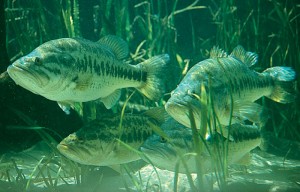Our conversation headed to size and records. His record was only eight, he said, but it should be and would be 15. A pair of them. Both state records.
“Where?” I asked.
“Right here,” he said. “One cove over, although I have never gotten them to bite.”
“You can see them?”
“Not likely,” he said. “The water’s pretty clear now, but these fish sit in 15 feet of water right next to a big submerged tree. Typically, you have to scuba dive down to see them. That’s how we found them the first time. I’ve only seen them roam the shoreline once.”
“You’re kidding.”
“No. I’m for real.” He was. I could see the honesty in the dark tan lines at the edge of his eyes.
Before I even had the chance to ask him, he was pulling up the trolling motor and putting on his life jacket to head over to the next cove.
“I’ve seen them three times while scuba diving,” he said as we pulled into the cove. “The guy that found them has seen them at least six or seven times. I didn’t believe him the first time he told me, since he is not a fisherman. He does scuba for fun and water skiing and stuff. When he took me down there, my eyes about popped out of my head.” Gary let out a huge chuckle as he made a funny expression with his eyes bulging. I laughed.
“It hasn’t rained for a month, and the water is so clear and low right now. If they are relating to that log, there is a remote possibility that we could see them. I haven’t come by this way for a while.”
The water sparkled with light ripples off the water at the entrance. Trees lined the shoreline. The water inside the cove was still and calm. Gary killed the engine and used the trolling motor the rest of the way in.
“The key is polarized sunglasses,” Gary said.
He tied a new hair jig on the end of my line and put on a fresh piece of pork. “I doubt they will bite, but hey, why not try?”
His strategy was to cast the deeper edges of the spot first, where the fish likely had moved to avoid the hot sun, especially with the low water level.
We fished the jigs without a bite, and then moved in closer. Nothing.
Right up toward the bank, I could see the tree about 10 feet under the surface. Some bluegill darted away when the shadow of the boat covered their hanging spot. Then, far to our right, along the bank, I saw them. They were a giant pair of northern largemouth bass, cruising the shoreline as bass do, looking for an easy meal in six feet of water.
They swam right toward the boat, which had now drifted over their hiding place. When they saw us, they were not alarmed; they simply swam deeper. Gary’s line was still in the water as he jigged the shoreline side of the tree. Mesmerized by the fish, I did not even say anything. I smiled to myself when I saw his serious expression as he worked his jig ever so slowly. The bass came up shallower once they passed the boat and continued down their stretch of shoreline.
 I did not say anything to Gary about seeing the fish. My mind was formulating a live bait setup to catch those fish another time on my own.
I did not say anything to Gary about seeing the fish. My mind was formulating a live bait setup to catch those fish another time on my own.
When we pulled up toward the ramp, Gary gave me the pro guide’s sermon I have heard a dozen times since:
“Well, we did pretty good today considering the conditions. We caught a few fish and learned some new techniques. We discovered that depending on weather and sunlight conditions, fish don’t always bite or let themselves be caught.”
He continued on, and I would not have been surprised if an announcer’s voice was heard above saying, “And now for these messages from our sponsors.”
I wondered how many hours he dedicated to fishing that one spot. He shared the fact that he would give up after some days with absolutely no luck. Others had likely seen those bass and tried in vain to catch them. Those Missouri state-record bass were no different than world-records. They are out there, but that does not mean that they are going to be caught. If they are caught, that does not mean that they will make the record books or that tackle sponsors will pay the successful angler. The “million-dollar fish,” as they call it, might be a pipe dream. These fish are as elusive as they come.
Copyright 2012 Jason Covington
U.S. Library of Congress
